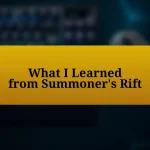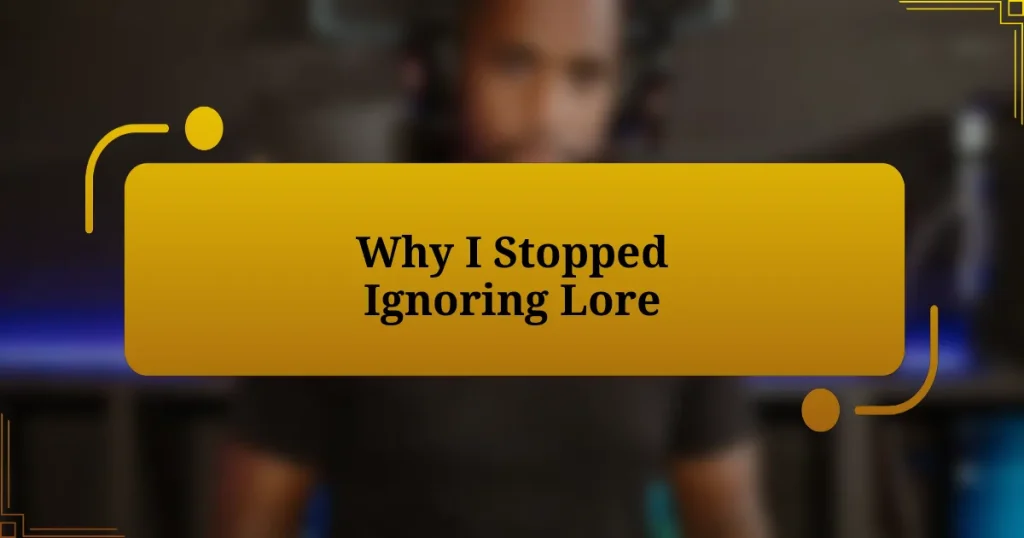Key takeaways:
- Understanding champion matchups involves analyzing strengths, weaknesses, and adapting strategies based on ability interactions and gameplay dynamics.
- Champions’ win rates, gameplay footage, and community insights are crucial for gathering data and improving matchup knowledge.
- Personalizing champion strategies through synergy with teammates and adapting to the current meta can significantly enhance gameplay effectiveness.
- Effective communication and real-time analysis in live games are key to adapting strategies and recognizing optimal opportunities for engagement.
Author: Clara M. Ashford
Bio: Clara M. Ashford is an award-winning author known for her captivating literary fiction that explores the complexities of human relationships and the intricacies of personal identity. With a background in psychology and a passion for storytelling, Clara weaves rich narratives that resonate with readers on a profound level. Her debut novel, Whispers of the Heart, garnered critical acclaim and was shortlisted for the National Book Award. When she’s not writing, Clara enjoys hiking in the mountains of Colorado and volunteering at local literacy programs. She lives in Denver with her two adventurous dogs.
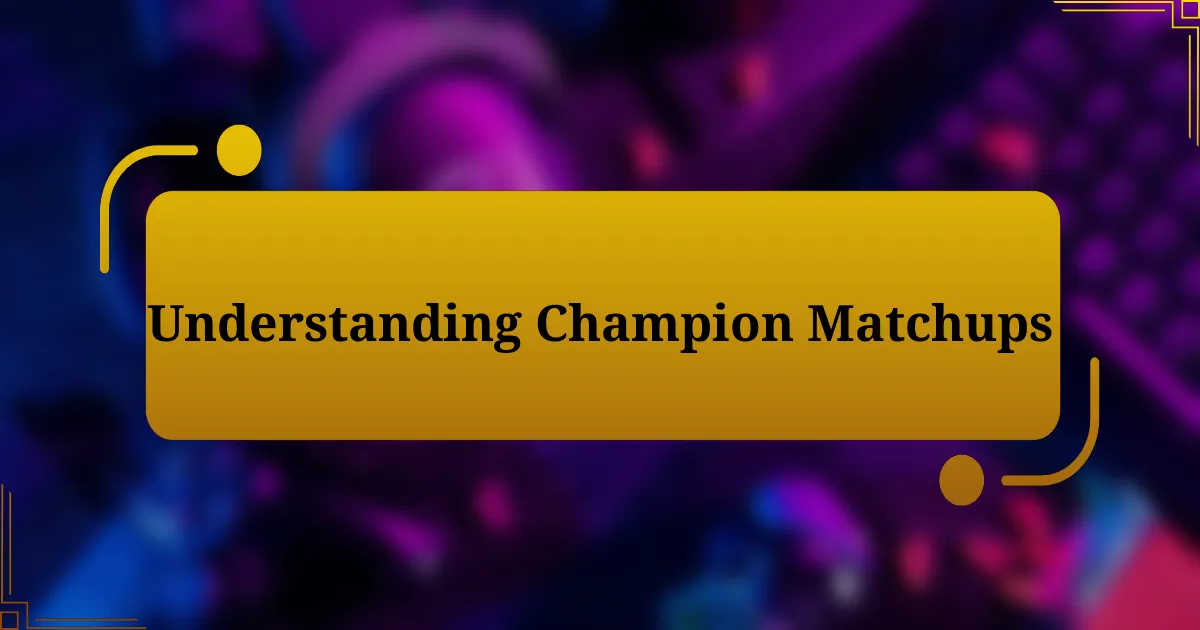
Understanding Champion Matchups
When it comes to champion matchups, understanding the unique strengths and weaknesses is crucial. I remember a game where I selected Zed against a poorly positioned Lux. I felt a sense of excitement knowing that my mobility would give me a clear advantage, but it was also a reminder that every choice in a matchup can shape the game’s outcome.
Have you ever faced a situation where the unexpected happened, flipping your expectations? I once encountered a Singed who completely thwarted my attempts with Fiora. At first, I underestimated the matchup, thinking my abilities would dominate, but his poison and mobility turned the tables. This experience taught me that even seemingly favorable matchups require constant vigilance and adaptability.
In analyzing champion matchups, I always consider factors like crowd control and damage output. Reflecting on my playstyle, I often ask myself, “How can I maximize my champion’s strengths while mitigating my opponent’s advantages?” By diving deep into this strategy, I can better anticipate what will happen in the lane or during team fights, enhancing my overall gameplay experience.

Importance of Champion Matchups
Analyzing champion matchups is vital because it can significantly influence the course of the game. For instance, I remember a tense matchup with Kha’Zix against an invading Lee Sin. It was a decision point: knowing that Lee’s exerted pressure could be overwhelming, I had to play cautiously, leveraging stealth and burst damage when the opportunity presented itself. It’s these kinds of interactions that can determine whether you thrive or struggle in your lane.
The importance of matchups extends beyond just recognizing who to counter. I’ve felt the weight of misunderstanding a matchup firsthand; when I played Katarina against a Malphite, I underestimated his ability to negate my damage with his ultimate. It was a humbling moment that reinforced the reality—adaptability is key. How often do we find ourselves in situations that test our knowledge and preparation?
Furthermore, the psychological aspect of matchups can’t be ignored. I’ve seen players become overly aggressive or too passive based on their opponent’s champion. I recall a game where I deliberately played defensively against a Riven despite being ahead; I knew she could outplay me in skilled hands. That delicate balance of knowing when to engage or retreat is what makes understanding champion matchups indispensable for anyone looking to improve.
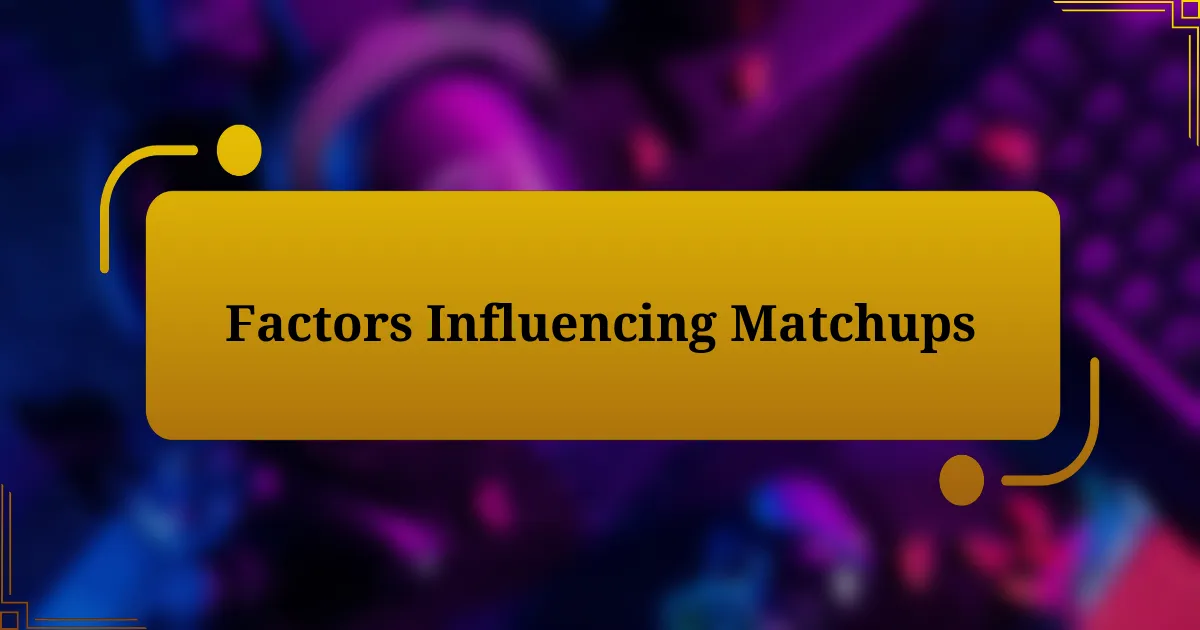
Factors Influencing Matchups
When considering the nuances of champion matchups, the role of champion abilities and their interactions cannot be overstated. I once found myself playing Zed against a Lissandra, and I’ll never forget how her Ice Shard effectively thwarted my attempts to engage. This was a crucial learning moment; knowing her kit allowed me to rethink my strategy. How often do we fail to account for the nuances of ability interactions, only to end up regretting it in-game?
Itemization also plays a critical role in shaping matchups. I remember a game where I chose to rush Armor items against a heavy AD composition. This decision allowed me to survive and thrive in trades that previously seemed daunting. Have you ever switched up your build mid-game based on your opponent and felt that glorious shift in momentum? That moment of clarity can completely alter the pacing of a matchup.
Lastly, the impact of player skill and experience is undeniable. It’s fascinating how my personal knowledge can shift the battle’s tide. There was a match where I faced a Lux, and while I was somewhat ahead, her experience allowed her to land critical skill shots that turned a favorable situation on its head. How important do you think practice and champion mastery are in ensuring consistent matchup advantages? Each game reinforces the idea that understanding factors influencing matchups is essential for any aspiring player.
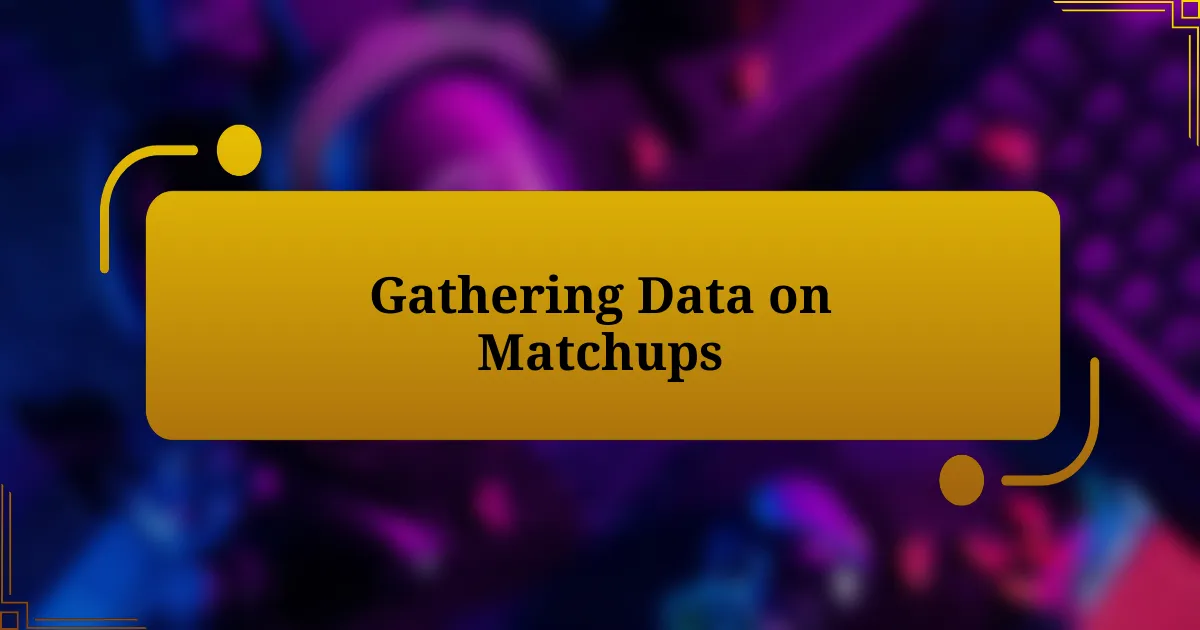
Gathering Data on Matchups
When gathering data on matchups, I find that analyzing win rates can offer valuable insights. For example, I recall a time when I poured over statistics for champions I like to play, trying to determine which ones were performing well in the current meta. It was surprising to see how a champion like Malphite had a high win rate against certain carries, reinforcing my decision to include him in my champion pool. Have you ever noticed how small shifts in the meta can redefine what champions are viable?
Beyond just win rates, checking out gameplay footage is a crucial step for me. I remember watching replays of top players facing off against popular champions. Observing how they approached difficult matchups opened my eyes to strategies I hadn’t considered, like using terrain effectively or timing engagement just right. How often do you take the time to study professional matches to find that one tip that could elevate your gameplay?
Lastly, community feedback on forums can be a goldmine. There was an instance where I stumbled upon a lengthy discussion about countering Yasuo with certain supports. The shared experiences and strategies from other players not only boosted my understanding but also provided me with innovative ideas to try in my games. Have you ever felt that rush when you implement advice from others and see it pay off? It’s these conversations that deepen our grasp on matchups beyond mere statistics.
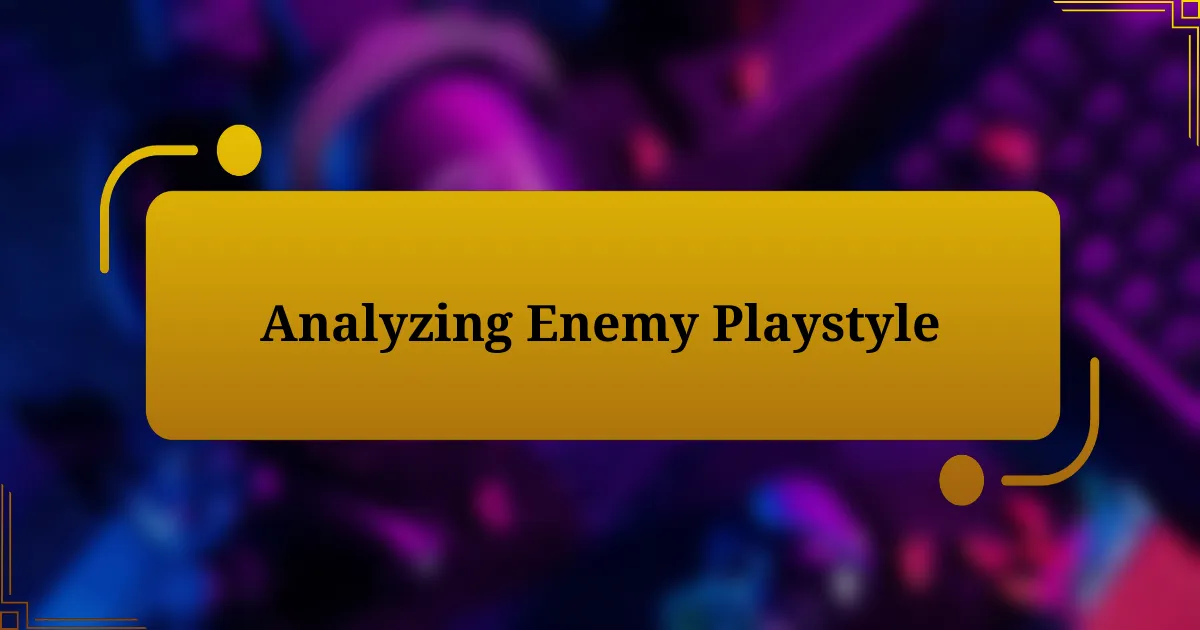
Analyzing Enemy Playstyle
When analyzing an enemy’s playstyle, I pay close attention to their movement patterns and decision-making. I once faced a Zed player who relied heavily on aggressive roaming and flanking maneuvers. Watching him zip around the map taught me the importance of vision control and positioning; I found myself placing wards in strategic spots, anticipating his next move. Have you ever had a game where you could practically feel the enemy’s next play before it happened?
I also consider how an opponent’s champion choice reflects their overall strategy. For instance, I encountered a Jinx who was more focused on scaling and positioning rather than aggressive trades. This shifted my approach entirely; instead of playing aggressively, I decided to control the pace of the lane and wait for the right moment to capitalize on her immobility. It’s fascinating how much information you can glean about your enemy’s intentions just by observing their tendencies and decisions throughout the match.
Finally, I find it crucial to remember that everyone has unique habits that shape their gameplay. In a recent match, I noticed an enemy Lux consistently overestimating her range, which led to several miscalculations in her abilities. I quickly adapted by baiting her spells and punishing her with aggressive trades afterward. Have you experienced a similar moment where you recognized a pattern and turned it to your advantage? Understanding these nuanced behaviors can be the key to outsmarting even the most formidable opponents.

Personalizing Your Champion Strategy
When it comes to personalizing my champion strategy, I find that understanding the strengths and weaknesses of my chosen champion is essential. For instance, I once played as Riven against a Malphite. Knowing that his armor would stack rapidly, I adapted my build to include more penetration items and focused on burst damage instead of prolonged trades. This shift not only turned the tide of our skirmishes but also deepened my appreciation for how flexibility can lead to victory.
I also consider the synergy between my champion and my teammates. In a recent game, my support picked Thresh, and I played Jhin. I quickly recognized the opportunity to capitalize on his hooks for setting up kills. These moments of coordination felt exhilarating, as we would communicate and time our abilities together. Have you ever felt that rush when your team functions like a well-oiled machine? That level of synergy not only boosts morale but also vastly increases your chances of success on the rift.
Beyond just individual matchups, I immerse myself in the current meta to refine my strategy. The evolving champion pool means staying updated on buffs, nerfs, and trends. I recall a time when I underestimated Aatrox after his rework. Once I started watching pro streams and studying the matchups, I began integrating strategies that countered his aggressive playstyle, elevating my game to new heights. How do you keep track of the ever-changing landscape of champion strengths? Adapting my approach based on current trends has proven vital in maintaining relevance and effectiveness in my gameplay.
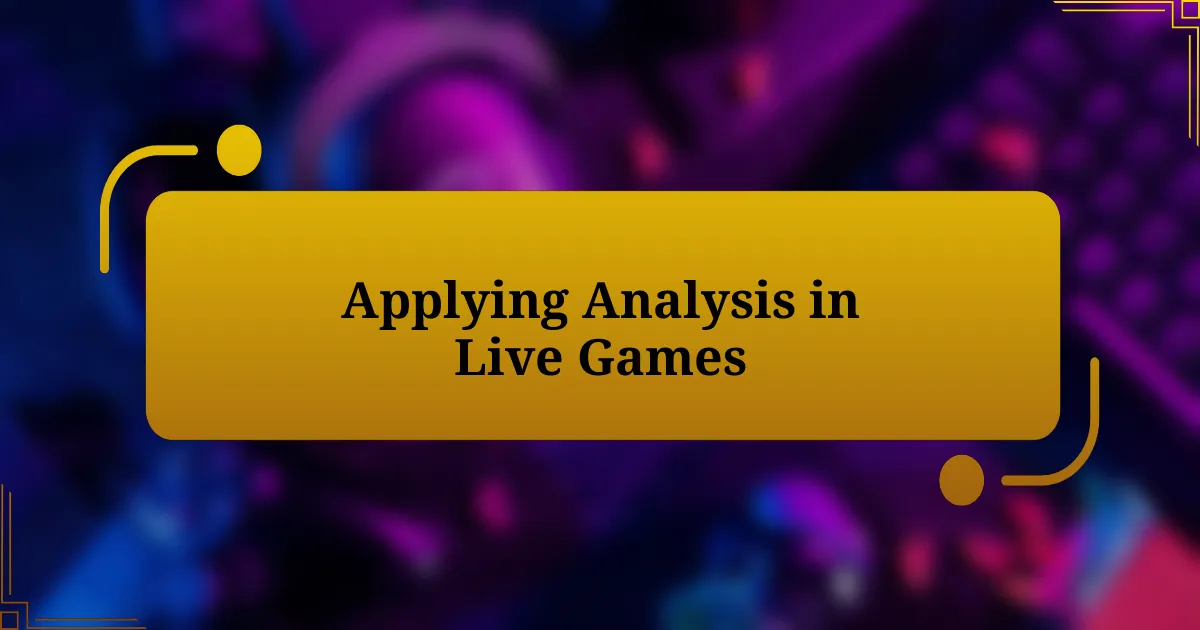
Applying Analysis in Live Games
One of the key aspects of applying analysis in live games is recognizing when to adapt mid-match. I remember a game where I was playing Akali against a Zed. Initially, I felt confident, but when he hit level six, I had to shift my tactics quickly. I started focusing on playing defensively, utilizing my shroud effectively, and looking for opportunities to outmaneuver him instead of engaging him directly. This shift kept me alive and allowed me to set up for plays when he was overcommitted. How do you know when it’s time to switch gears?
Communication also plays a significant role during live matches. In a tense game, I found myself coordinating with my jungler to dissect the enemy’s rotations. We spotted the enemy ADC overextending, and with a simple ping and call to action, we set up a perfect ambush. The thrill of executing that plan, knowing that my analysis of the enemy’s positioning directly contributed to our advantage, was incredibly fulfilling. Have you ever experienced that rush of perfect teamwork that stems from clear communication?
Lastly, I can’t stress enough the importance of constantly assessing the game flow. In one match, I realized that the enemy team was building heavy on crowd control, which meant I had to prioritize items that offered tenacity. This decision not only kept me in fights longer but also empowered my teammates to be more aggressive. Recognizing those subtle shifts in itemization and playstyle can be the difference between a win and a loss. How do you adapt your build choices based on the evolving match dynamics?










